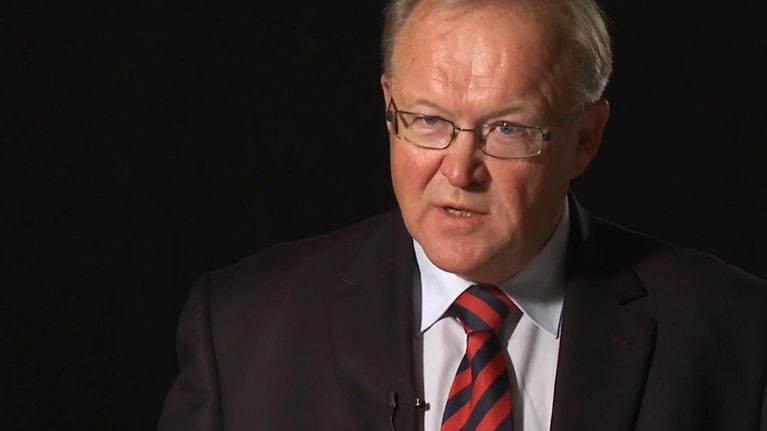In the present euro crisis, many references are made to the Swedish experience in the early 1990s. Clearly, there are similarities: a real-estate bubble, bank bailouts, falling consumption, a recession, double-digit budget deficits, a weak market for state bonds, spiking interest rates, and the skyrocketing cost of debt maintenance.
As the new government took office in October 1994, Sweden was caught in the vicious circle that many European countries face today. Four years later, in 1998, Sweden had a budget surplus, solid growth, decreasing unemployment, and a reelected government. Even today, Sweden is one of few European countries with a national debt that’s less than 40 percent of GDP and a balanced budget.
Every country, of course, has a unique set of issues and requires a unique solution Still, there are lessons from Sweden that have a bearing on the situation today, both regarding personal leadership and the design and implementation of reforms.
Leadership
In my experience, any politician facing a large budget consolidation must have three personal and nonnegotiable commitments:
- Show true leadership. Someone has to take the lead and create momentum. That is a political kamikaze mission, impossible unless you are truly ready to put your job at stake. The desire to do right must be greater than the ambition to cling to power. Ultimately, you must accept that you have a personal responsibility to foster public respect for the political system and protect the strength of the democracy.
- Create impact. This issue is not really one of economics but of politics. It is easy to understand what needs to be done. The challenge is to do it, continuously building the majorities needed for the number of years required to implement the program. Having genuine impact takes reflection, it takes skill, and it takes endurance.
- Communicate. You cannot count on popular support, but you must maintain the respect of the people. Communication is key. Be transparent. Find ways to describe the situation so that people understand why you’re taking the steps you’re taking. Stick to your messages. Just as important: don’t get trapped in wishful thinking. Be conservative in any forecast you make so that any surprises are positive, and don’t ever pretend it won’t hurt—it will
Five cornerstones of reform
In addition, there has to be a rigorously structured plan. The turnaround of the Swedish economy contained five cornerstones that are usually found in the most difficult reform approaches, programs that are large, necessary—and unpopular.
-
Get a reality check. Naturally, the first phase of every large reform has to be a thorough analysis. What is the situation we’re trying to address? What problems do we have to solve? What do we know, what do we believe, and what additional knowledge can we find? The problem with this process of analysis is that almost everyone, including the experts, has a vested interest—based on ideology, personal implications, or pecuniary reasons. At this stage, policy makers need to question every conclusion, even those that originate with their own agencies, in order to develop a conviction that will withstand the tough scrutiny of everyone from professors to blue-collar workers.
I believe that the more transparent the formation of this analysis is, the better. A public discussion will both make conflicting interests examine other arguments and make citizens more aware of the problems and thus more open to reform.
- Construct a reform program. To push through a genuinely unpopular reform, such as a budget consolidation, the reform must do two things: offer a solution to a crisis and include safeguards to make sure the crisis does not recur. In Sweden, the immediate budget measures, tax increases, and cuts in social insurance programs, pensions, and public services were combined with structural reforms, including a new budget law ensuring better control over expenditure, a sustainable pension system, improved wage formation, and liberalization of state monopoly markets such as telecommunication and electricity.
Both parts of the program—the direct action and the structural change—reinforced each other. In the short term, the structural reform contributed to trust in the long-term ability to maintain a balanced budget, bringing interest rates down. Actually balancing the budget gave the government the maneuvering room to enact the difficult structural reforms.
A successful reform program must also address the domestic cultural and political logic. In Sweden, a key enabler was a strong focus on a fair distribution of burdens. With the egalitarian set of values that characterize Sweden, solidarity was important. It is always the families that already have problems making ends meet that will take the largest blows from any austerity package. They have limited savings, small margins, and are often recipients of public transfers. They often have young children or they are retired. In both cases, they are more dependent on public services such as child care, elder care, and schools than the population at large. With these factors in mind, we carefully analyzed the distribution of burdens in the various parts of the reform program; from the beginning, we described to the public exactly how the burdens would be shared, and we did so with each budget we presented.
- Get the mandate. The first two cornerstones are relatively simple. Again, the difficult thing is rarely to understand, but rather to do.
Every democratic politician has his or her power as a mandate, ultimately from the voters. It is formed around power centers, such as trade unions or employers’ federations, media, and specific individuals or companies. These centers must be understood, faced, and involved. It is an illusion to believe they will all agree to each unpopular decision, but it is essential to understand the consequences and have an idea of how to counteract or influence any major challenges they can create. Creating a common definition of the crisis and its components, as well as including critical power centers, makes it harder for such groups to launch full-scale confrontations.
The most important mandate, however, is in parliament. Regardless of whether you lead a majority or minority government, you must have solid support for the measures you take, and you have to ensure that the mandate lasts over a long period. To muddle through with one compromise at a time will quickly erode any momentum the reform might have had. And if you don’t have support you can rely on, you will constantly be searching for new partners, which takes time. Even worse, with every change of partner, the measures you enact will deviate further and further from the original plan.
A solid majority must be based on a common understanding: “Yes, it will be difficult, and popular support will diminish, but in the long term, the electorate will reward those who do the right things for the country and deliver. And in order to deliver, we have to stick together—no matter what happens.”
During the Swedish budget consolidation, the Social Democratic government gained tremendously from cooperating with the Centre party. It was this broad coalition—based on trust rather than written agreements—that finally persuaded investors to trust us to deliver.
- Execute. Execution is, in essence, a matter of good management. It is impossible to control all parts of the implementation, and there is rarely time to construct detailed instructions for every part of the administration in the state, regions, and municipalities. Further, many of the agencies and authorities run highly professional and complex operations. Making centralized decisions on exactly how to meet new budget requirements is discouraging and will ultimately lead to many poor decisions. Instead, it is important to ensure that the administration is motivated and has clear targets. All those who are responsible must have the freedom to execute but at the same time be accountable for the results of their actions.
The entire administration must understand the reasons for the reforms, the targets, and the importance of everyone contributing. As a leader, you have to stand up, be clear and open, meet the inevitable criticism, take action when managers do not deliver, and explain why, perhaps many times. You have to be compassionate with the people affected but firm in standing up for the measures taken and the path chosen. That is why communication is so important.
This is not a one-night show. Most large reform programs last for many years and consist of thousands of decisions and hundreds of bills to parliament. There will be many critical articles in the media and many disappointed people that you have to face during execution. It takes endurance. It takes a strong central team. It takes delegation.
- Shift to a new agenda. Almost all politicians in democracies have entered into politics for a single reason: they want to do good. They have different ideas of what good is, but that is their motivation—improve the world, their countries, and the people they serve. In a company, you can motivate staff with bonuses or other material incentives. That is impossible in politics. To endure a lengthy, unpopular reform program, it is almost a prerequisite to combine execution with planning ahead for more constructive and positive reforms once the austerity measures have done their work.
When the largest hurdles are passed and the momentum is still strong, it is time to communicate new ambitions. In late 1996—two years into the Swedish budget consolidation program—we started to refocus the rhetoric from austerity to fighting unemployment and prioritizing schools and health care once we achieved a balanced budget and solid growth
By defining a new agenda, it became clear to everyone that the target in itself was not austerity, but jobs, education, and health. It was a light in the tunnel for the people who had endured years of austerity. It also served as new fuel for the administration, motivating them not to stop halfway through, but rather to finish the job and create a solid surplus that could be used for future improvements.
On the other hand, had those cheerier goals been brought forward too early, they would have destroyed the consolidation altogether. You can’t reduce the number of nurses and at the same time say that more money will be put into health care in a couple years’ time. That would confuse voters, upset investors, and jeopardize everything achieved.
Maybe the most important thing to understand is that you won’t have perfect understanding. I have seen many politicians become paralyzed by the search for the perfect solution. And while they analyze, the problem grows and eventually someone else—the opposition, interest groups, the market—will take the initiative. Then it is virtually impossible to drive reform.
No silver bullets
Each crisis is unique and requires a unique program. Still, many failed reforms can be explained by the lack of one or more of these cornerstones. Many politicians have known very well what to do but failed in execution. Many have had the mandate from the people but missed the majority in the parliament. Many have—despite a majority in parliament—failed to motivate the administration. And many have failed to fully achieve their goals because they lost their political mission while pushing through unpopular decisions and either lost momentum or lost an election.
It is difficult to take a holistic approach under the extreme pressure of a budget collapse or other crises. But doing so is of tremendous importance. If politicians fail to deliver on the difficult issues—not only sovereign-debt reduction but also innovation and growth, ecological sustainability, global trade, and decent distribution of wealth and income—then political power will deteriorate. Ultimately, democracy will become shallow and vulnerable.


